C04 Pasar Senen Station Stasiun Pasar Senen | |||||||||||
|---|---|---|---|---|---|---|---|---|---|---|---|
| Inter-city rail and commuter rail station | |||||||||||
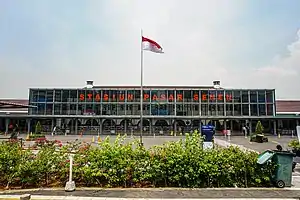 The façade of Pasar Senen Station, taken on 16 October 2020. | |||||||||||
| General information | |||||||||||
| Location | Jl. Stasiun Senen No. 14, Senen, Senen, Central Jakarta Jakarta Indonesia | ||||||||||
| Coordinates | 6°10′28″S 106°50′40″E / 6.17444°S 106.84444°E | ||||||||||
| Elevation | +4.7 m (15 ft) | ||||||||||
| Owned by | Kereta Api Indonesia | ||||||||||
| Operated by | Kereta Api Indonesia KAI Commuter | ||||||||||
| Line(s) | |||||||||||
| Platforms | 1 island platform 2 side platforms | ||||||||||
| Tracks | 6 | ||||||||||
| Connections | |||||||||||
| Construction | |||||||||||
| Parking | |||||||||||
| Bicycle facilities | |||||||||||
| Accessible | |||||||||||
| Architect | J. van Gendt | ||||||||||
| Architectural style | New Indies | ||||||||||
| Other information | |||||||||||
| Station code | PSE • 0470[1] | ||||||||||
| Classification | Large type A[1] | ||||||||||
| History | |||||||||||
| Opened | 1887 | ||||||||||
| Rebuilt | 1925 | ||||||||||
| Electrified | 1925 | ||||||||||
| Services | |||||||||||
| |||||||||||
| Location | |||||||||||
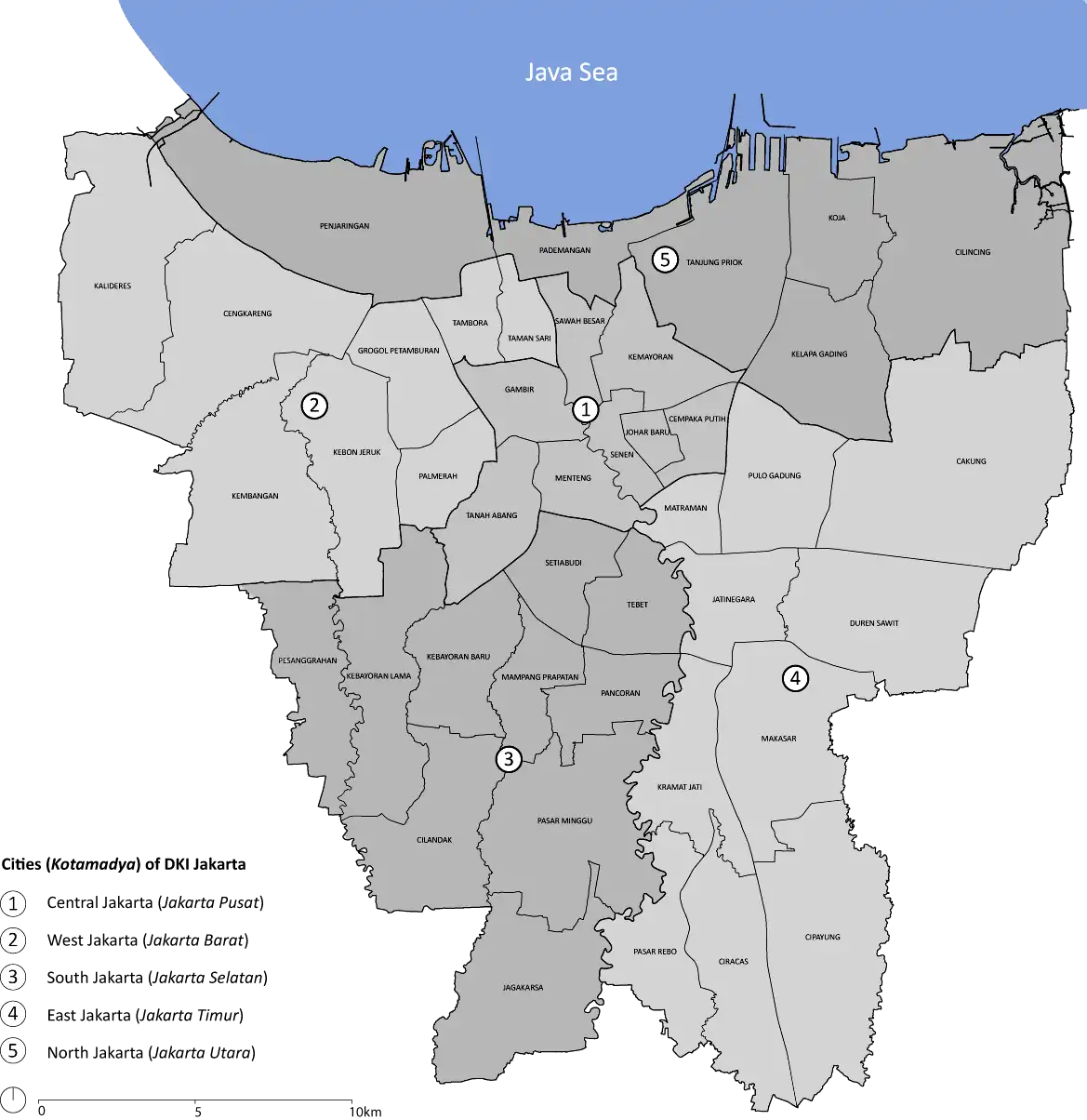 Pasar Senen Station Location in Jakarta | |||||||||||
Pasar Senen Station (PSE)[1] is a railway station located in Jakarta, Indonesia. It is the second largest railway station in Jakarta after Gambir Station. It is located close to Pasar Senen market area in Senen, Senen, Central Jakarta. The current building was built in 1918 and inaugurated on 19 March 1925.
Pasar Senen only serves Economy and Business class intercity train except Gumarang and Sawunggalih. It also serves as a station for northbound KRL Commuterline trains.
History
Background
The name of this train station comes from a market with the same name. It is called Pasar Senen because this market is only open on Mondays; founded by the Colonial Government in 1733 to revive the economy of the Weltevreden people who later became Gambir, Central Jakarta.[2][3][4]
During the leadership of Governor General Petrus Albertus van der Parra, Pasar Senen was getting busier so that it was open every day. Many Chinese traders opened their businesses in this market. Since independence until 1975, Pasar Senen has continued to be developed as a center for Senen trading and has become the backbone of Jakarta's economy at that time.[4]
First generation (1887–1925)

The development of Pasar Senen requires adequate transportation facilities, especially trains. This station was opened by the Bataviasche Oosterspoorweg Maatschappij (BOS) on 31 March 1887 as a small stop. The opening of this station coincided with the opening of the Batavia-Bekasi railway line. The line was then bought by Staatsspoorwegen (SS) in 1898 because of BOS' debt which was swelling.[5]
In 1904, De Ingenieur magazine mentioned that this station had undergone renovations (possibly changing the building to become permanent). This development is also part of the construction of the Kemayoran Station, which both cost ƒ350,000.00.[6] This first generation station building was Indische Empire style, small, and had an arc overcapping roof similar to the Maos, Kutoarjo, and Purworejo Stations.[7]
Second generation (1925–now)

As passenger traffic increased, Pasar Senen Station was rebuilt with a fairly large face. Because it was affected by the construction of the new station, the old Pasar Senen Station had to be torn down. The station opened on 19 March 1925 after eight years of construction.[7] Having the layout of an island station, this station is equipped with two underground tunnels. There are two tunnels, one for departing passengers and one for exiting the station.[8]
This rebuilding was carried out to welcome the operation of the SS's new service, the electric multiple unit and to commemorate the 50th anniversary of the SS on 6 April 6 1925. SS presented a number of magnificent train stations in Batavia which were expected to provide passenger satisfaction.[9]
Currently the station building has the status of a cultural heritage by the Central Unit for Preservation and Architectural Design of PT KAI, the Ministry of Culture and Tourism, and the Provincial Government of DKI Jakarta. Determination of cultural heritage status is based on the Decree of the Minister of Culture and Tourism No: PM.13/PW.007/MKP/05 and Decree of the Governor of DKI Jakarta No. 475 of 1993.[10]
Building and layout
Main building
The station has six railway lines with lines 3 and 4 being straight tracks. This building was designed by J. van Gendt, with a Neo-Indische architectural style. Its vernacular character is very prominent, it can be seen from the dominating pyramid roof with eaves added above the entrance hall to protect the building from rainwater seepage, and when viewed from the outside it looks like a two-story building. The doors are in Romanesque style with exposed roof consoles.[11]
This station became popular because it was always visited by travelers who wanted to use rail services to various destinations on the island of Java.[12] In order to make passenger arrangements more comfortable, the Jakarta Operational Area I provides separate doors according to the type of train, namely for long-distance trains and for KRL Commuterline. In addition, there is also an underground tunnel that connects the platform lines 1 to 3 and lines 4 to 6.[13]
| G | Side platform, the doors are opened to the right of the train's departure from the east | |
| Line 6 | ← Intercity train arrival route | |
| Line 5 | The turning lane as well as parking for the train circuit | |
| Line 4 | Intercity train arrival track
The direct running track of the freight train direction to Tanjung Priuk/Jakarta Gudang Straight lines to Kampung Bandan | |
| Side platform, the doors are opened to the left of the train's departure from the east | ||
| Central building | ||
| Side platform, the doors are opened to the left of the train's departure to the east | ||
| Line 3 | Departure line for long series intercity trains
The direct running track of the freight train from Tanjung Priuk/Jakarta Gudang Straight lines to Jatinegara | |
| Line 2 | The turning lane as well as parking for the train circuit | |
| Line 1 | Intercity train departure routes | |
| Side platform, the doors are opened to the right of the train's departure to the east | ||
| G | Main building | |
Tekad Merdeka Monument
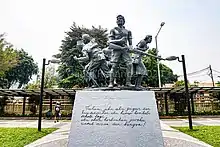
Pasar Senen station also have a monument at the frontage area, namely the "Tekad Merdeka Monument" or "Monumen Perjuangan Senen", has also been raised. This monument to commemorate the bloodshed against the Allied forces in the area of Senen on 29 September 1945 was inaugurated on 2 May 1982 by the Mayor of Central Jakarta, A. Munir. This monument was made with cement stone lathe cast concrete construction and was imported from Sleman Regency, Yogyakarta.[14]
Services
The station serves both KRL Commuterline and long-distance train. 34 long-distance trains depart from Pasar Senen station daily.[15]
Mixed Class
- Gumarang, from and to Surabaya Pasar Turi via Semarang Tawang (executive and business class)
- Sawunggalih, from and to Kutoarjo via Purwokerto (executive and economy premium class)
- Singasari, from and to Blitar via Purwokerto (executive and economy class)
- Fajar/Senja Utama Solo, from and to Solo Balapan via Purwokerto (executive and economy premium class)
- Fajar Utama YK, from and to Yogyakarta via Purwokerto (executive and economy premium class)
- Senja Utama YK, from and to Yogyakarta via Purwokerto (executive and economy premium class)
- Bogowonto, from and to Lempuyangan via Purwokerto (executive and economy plus class)
- Gajah Wong, from and to Lempuyangan via Purwokerto (executive and business class)
- Jayabaya, from and to Malang via Surabaya Pasar Turi (executive and economy plus class)
- Mataram, from and to Solo Balapan via Purwokerto (executive and business class)
- Gaya Baru Malam Selatan, from and to Surabaya Gubeng (executive and economy plus class)
- Bangunkarta, from and to Jombang (executive and economy plus class)
- Dharmawangsa, from and to Surabaya Pasar Turi (executive and economy class)
- Brantas, from and to Blitar via Semarang Poncol (executive and economy class)
- Kutojaya Utara Fakultatif, from and to Kutoarjo (business and economy class)
- Kertajaya Tambahan, from and to Surabaya Pasar Turi (business and economy class)
- Brantas Tambahan, from and to Blitar via Semarang (business and economy class)
Note:
* Brantas Tambahan & Kertajaya Tambahan only operates during high season e.g. new year, eid al fitr
* Kutojaya Utara Fakultatif only operates during weekends & high season e.g. new year, eid al fitr
Premium Economy Class
- Jayakarta, from and to Surabaya Gubeng via Yogyakarta
- Tawang Jaya Premium, from and to Semarang Tawang
- Kutojaya Utara, to Kutoarjo and Jakarta Kota
Economy Plus Class
- Majapahit, from and to Malang via Semarang-Madiun-Blitar
- Jaka Tingkir, from and to Lempuyangan
- Menoreh, to Semarang Tawang Bank Jateng and Pasar Senen
Economy Class
- Matarmaja, (reguler and tambahan), from and to Malang via Semarang-Solo-Madiun-Blitar
- Bengawan, from and to Purwosari
- Progo, from and to Lempuyangan via Purwokerto
- Tawang Jaya, from and to Semarang Poncol
- Serayu, from and to Purwokerto via Kiaracondong-Kroya
KAI Commuter
%252C_Pasar_Senen%252C_Oct_2019.jpg.webp)
 Cikarang Loop Line (Full Racket)
Cikarang Loop Line (Full Racket)
- to Cikarang (counter-clockwise via Tanah Abang and Manggarai)
Supporting transportation
The frontage of Pasar Senen Station has undergone a complete overhaul and was inaugurated by Minister of State-Owned Enterprises Erick Thohir, Minister of Transportation Budi Karya Sumadi, and the Governor of Jakarta Anies Baswedan on 17 June 2020. This renovation program is a collaborative project of KAI, the government of Jakarta, and the Jakarta MRT. The 1,427.5 m2 land in front of the station is made into a plaza with pedestrian and disabled access and is integrated with the Pasar Senen and Senen Central TransJakarta BRT Stations as well as online motorcycle taxis and auto-rickshaw pick-up points. In order to create a healthy area, the plaza also has a shade canopy, green open space and bicycle parking racks.[16]
| Type | Station | Route | Destination |
|---|---|---|---|
| TransJakarta | Pasar Senen | Harmoni Central—Pulo Gadung 1 | |
| Rawa Buaya—Pulo Gadung 1 | |||
| 7F | Kampung Rambutan—Juanda via Cempaka Putih | ||
| Jakarta International Stadium–Senen (under public trial run) | |||
| PRJ3 | Pulo Gadung–JIExpo Kemayoran (only operates during the Jakarta Fair and/or other events on JIExpo Kemayoran) | ||
| Senen Central | Ancol—Kampung Melayu | ||
| Ancol—PGC 1 | |||
| PRJ2 | JIExpo Kemayoran—Matraman Baru (only operates during the Jakarta Fair and/or other events on JIExpo Kemayoran) | ||
| N/A | 1P (MetroTrans EV) | Pasar Senen Bus Terminal—Blok M Bus Terminal | |
| 1R (MetroTrans) | Pasar Senen Bus Terminal—Tanah Abang Station | ||
| 2P (Non BRT) | Pasar Senen Bus Terminal—Gondangdia station | ||
| Senen Central | 6H (Non BRT) | Pasar Senen Bus Terminal—Lebak Bulus via Menteng Raya—Cikini Raya) | |
| N/A | 12B (Non BRT) | Pasar Senen Bus Terminal—Pluit via Mangga Dua | |
| 14B (Non BRT) | Pasar Senen Bus Terminal—Tanjung Priok Bus Terminal via Utan Panjang Barat/Timur—Danau Sunter Barat | ||
| JAK 10B (MikroTrans Jak Lingko) | Gondangdia station—Cikini station via Kramat | ||
| JAK 17 (MikroTrans Jak Lingko) | Pasar Senen Bus Terminal—Pulo Gadung Bus Terminal via Pemuda | ||
| JAK 24 (MikroTrans Jak Lingko) | Pasar Senen Bus Terminal—Pulo Gadung Bus Terminalvia Yos Sudarso—Boulevard Barat Kelapa Gading | ||
| Mikrolet | M01 | Pasar Senen—Kampung Melayu | |
| M12 | Pasar Senen—Jakarta Kota | ||
| M35 | TPasar Senen—Pisangan Baru | ||
| M37 | Pasar Senen Bus Terminal—Pulo Gadung Bus Terminal via Sumur Batu Raya, Yos Sudarso, Boulevard Barat Kelapa Gading | ||
| M46 | Pasar Senen Bus Terminal—Pulo Gadung Bus Terminal via Cempaka Putih Tengah, Pemuda | ||
| Transjabodetabek | P9A (Mayasari Bakti) | Pasar Senen Bus Terminal—Bekasi Bus Terminal via Bekasi Timur | |
| AC100A (MetroMini) | Pasar Senen Bus Terminal—Cileungsi Bus Terminalvia Cibubur | ||
| x2 (Perum DAMRI) | Pasar Senen Bus Terminal—Pondok Cabe Bus Terminal via Sudirman—Thamrin—R.S. Fatmawati |
Gallery

 The COVID-19 rapid test service on Pasar Senen station
The COVID-19 rapid test service on Pasar Senen station The east emplacement of Pasar Senen Station on 20 December 2009
The east emplacement of Pasar Senen Station on 20 December 2009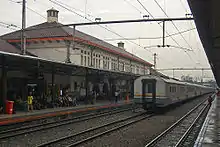 The platform of the station
The platform of the station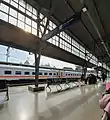 The waiting room of the station
The waiting room of the station
References
- 1 2 3 Buku Informasi Direktorat Jenderal Perkeretaapian 2014 (PDF) (in Indonesian). Archived from the original (PDF) on 1 January 2020. Retrieved 14 April 2023.
- ↑ "Pasar Senen dari Masa ke Masa". KOMPAS.com (in Indonesian). 20 January 2017. Retrieved 9 February 2023.
- ↑ Stasiun Senen, Jakarta.go.id
- 1 2 Unit Pusat Pelestarian dan Desain Arsitektur PT KAI 2014, p. 18.
- ↑ Perquin, B.L.M.C. (1921). Indische spoorweg-politiek. Vol. 1. Weltevreden: Bureau Industria. p. 58.
- ↑ Uit Ons Parlement: Begrooting van Ned.-Indië voor 1905: Staatsspoorwegen. De Ingenieur. 1904. p. 697.
- 1 2 "Stasiun Pasar Senen, Stasiun Bersejarah yang Menjadi Stasiun Terpadu". Kereta Api Indonesia. Retrieved 9 February 2023.
- ↑ Sleeswijk 1929, p. 8.
- ↑ Sleeswijk 1929, p. 11.
- ↑ Yuliani, Putri Anisa. "Kawasan Stasiun Bersejarah Pasar Senen Jadi Kawasan Terpadu". Media Indonesia (in Indonesian). Retrieved 9 February 2023.
- ↑ Unit Pusat Pelestarian dan Desain Arsitektur PT KAI 2014, p. 15.
- ↑ "Beda Suasana di Stasiun Gambir dan Senen Saat Musim Mudik Lebaran". KOMPAS.com (in Indonesian). 21 June 2017. Retrieved 9 February 2023.
- ↑ Sudarsih 2014, p. 11.
- ↑ "Sempat Terlupakan, KAI Munculkan Lagi Monumen Perjuangan Senen". Bisnis.com (in Indonesian). 21 July 2020. Retrieved 9 February 2023.
- ↑ "143,465 Homecomers Depart from Jakarta through Pasar Senen Train Station". Netral News.
- ↑ Sofuroh, Faidah Umu (22 July 2020). "Dibangun Zaman Kolonial, Stasiun Pasar Senen Punya Wajah Baru". detikTravel (in Indonesian). Jakarta: detikcom. Retrieved 9 February 2023.
Cited works
- Sleeswijk, F.O.W. (12 January 1929). "Uitbreiding van de spoorwegen in en om Batavia en Tandjong Priok". De Ingenieur. No. 2.
- Sudarsih, A. (2014). "Pasar Senen (PSE): Tersibuk di Musim Mudik". Majalah KA. Vol. 97. pp. 16–17. ISSN 2087-9458.
- Unit Pusat Pelestarian dan Desain Arsitektur PT KAI (2014). "Riwayat Stasiun Pasar Senen". Majalah KA. Vol. 97. p. 18. ISSN 2087-9458.
External links
- PT KAI - the Indonesian rail company (in Indonesian)
| Preceding station | Kereta Api Indonesia | Following station | ||
|---|---|---|---|---|
| Kemayoran towards Rajawali |
Rajawali–Cikampek | Gang Sentiong towards Cikampek |